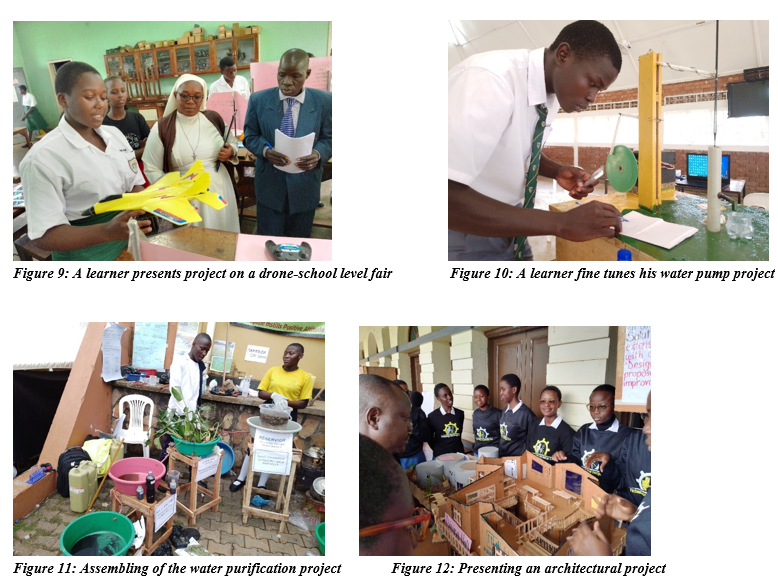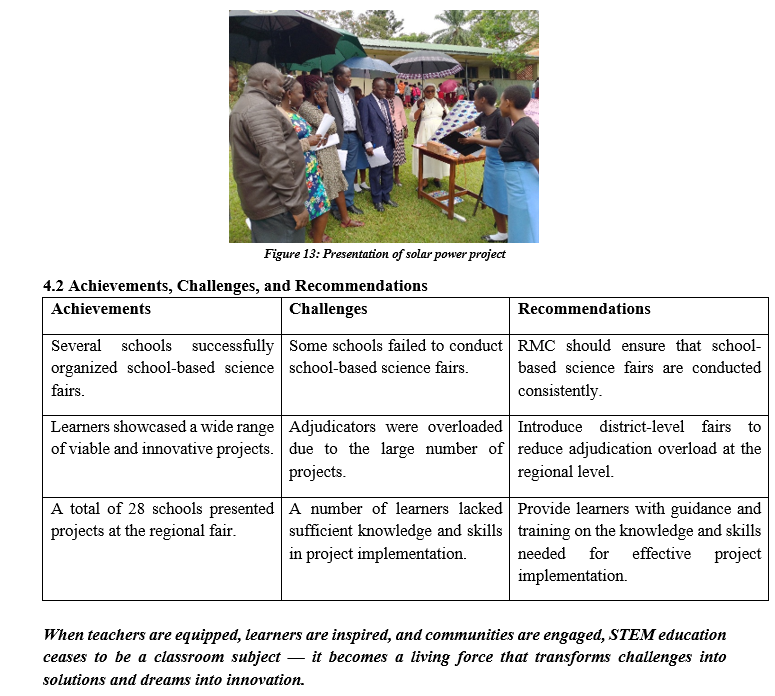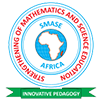Equipping Teachers, Nurturing Innovators: SESEMAT’s Multi-Faceted STEM Agenda in Mukono region-Uganda 2024- 2025
Welcome to Mukono’s STEM journey — where teachers are empowered, learners are inspired, and innovation takes center stage. Through INSET trainings, classroom supervision, regional assessments, and science fairs, SESEMAT is transforming education into a hands-on, competence-driven experience that prepares the next generation of problem-solvers.
SESEMAT Mukono region carries out various activities that enhance skills in Science Technology Engineering and Mathematics (STEM)in the learners. This article includes activities done in period of 2024 – 2025.
- INSETS.
Mukono Region has made INSETs a cornerstone of the national SESEMAT program, turning them into powerful platforms for professional growth. Each year’s training is carefully tailored to address emerging needs, guided by thorough needs assessments. With the rollout of the New Lower Secondary Curriculum (NLSC), these needs have shifted dramatically — demanding new skills, fresh strategies, and innovative approaches. SESEMAT’s methodologies have risen to the challenge, seamlessly aligning with the NLSC and breathing new energy into STEM teaching and learning.
In 2024 and 2025, Mukono Region’s INSETs focused on building teacher competence in delivering the New Lower Secondary Curriculum (NLSC). Each year’s training was carefully tailored to address emerging needs, equipping science and mathematics teachers with practical skills for teaching, learning, and assessment under the Competency-Based Curriculum (CBC).
1.1 2024 INSET (3rd–7th May, Mt. St. Mary’s College Namagunga)
The 2024 training aimed to strengthen teachers’ capacity to develop high-quality end-of-year assessment items for learners in S.1–S.3. It also emphasized a deeper understanding of the NLSC framework and the importance of school-based assessment through the Activity of Integration.
The specific objectives were to:
- Consolidate previous SESEMAT training on the NLSC.
- Equip teachers with the skills to set assessment items aligned to the NLSC.
- Deepen appreciation of the mechanisms of teaching in the NLSC.
- Promote understanding of school-based assessment through the Activity of Integration and its role in the CBC.
1.2 2025 INSET (7th–11th May, Mt. St. Mary’s College Namagunga)
The 2025 INSET shifted focus to strengthening classroom practice, with greater emphasis on problem-solving, project work, and quality assessments through problem-based learning as a methodology. Teachers explored their role not only as facilitators of learning but also as assessors of competence, ensuring that classroom activities reflected the demands of the CBC.
The specific objectives were to:
- Equip teachers with skills to design meaningful, problem-solving lesson activities.
- Reinforce appreciation of the teacher’s role as facilitator and assessor in project work, a core element of the NLSC.
- Build capacity to develop quality end-of-year assessment items for S.2.
- Emphasize the importance of the SESEMAT Activity Regional Based (SARB) framework and adapt it to align with CBC expectations.1.3 The Centrality of Lesson Activity in CBC
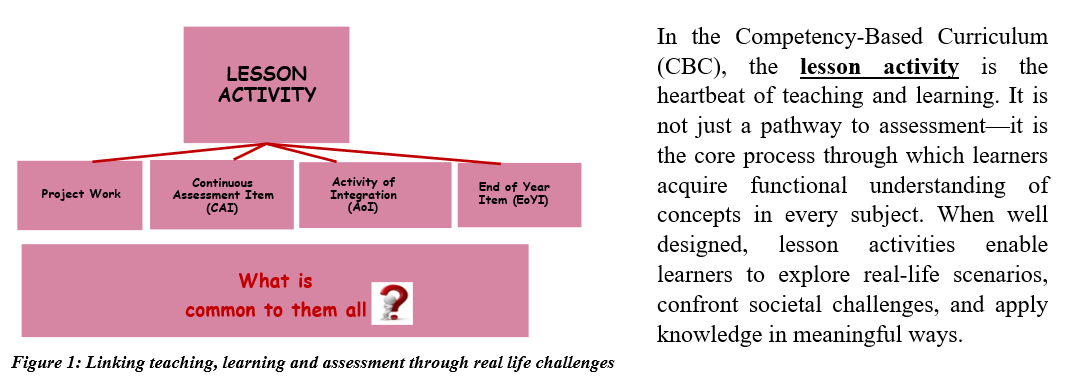
Project Work, Continuous Assessment Items (CAI), Activities of Integration (AoI), and End-of-Year Items (EoYI) all build upon lesson activities because they embody the same principle: functional learning rooted in context and relevance. The scenarios used go beyond memorization; they invite learners to solve problems, think critically, and link classroom knowledge to everyday life.
Yet, many teachers overlook this centrality, focusing more on delivery than on design. Without intentional, scenario-based lesson activities, learners miss the opportunity to develop competencies that prepare them for real-world demands. Lesson activities, therefore, are not optional—they are the bridge that turns curriculum intentions into authentic, transformative learning experiences.

1.4 Achievements 2024–2025 INSET
The INSETs engaged 375 teachers in 2024 and 326 in 2025, strengthening their ability to deliver the New Lower Secondary Curriculum (NLSC) through competence-based approaches. Teachers deepened their understanding of NLSC teaching mechanisms, valued school-based assessment through the Activity of Integration (AoI), and enhanced their skills in developing scenario-based assessment items that reflect real-life challenges.
They also gained capacity to design meaningful, problem-solving lesson activities, embraced their role as facilitators and assessors in project work, and improved their competence in creating quality end-of-year items for S.1–S.3. Importantly, teachers recognized the relevance of the region’s SESEMAT Activity Regional Based (SARB) and its adaptation to align with CBC expectations.
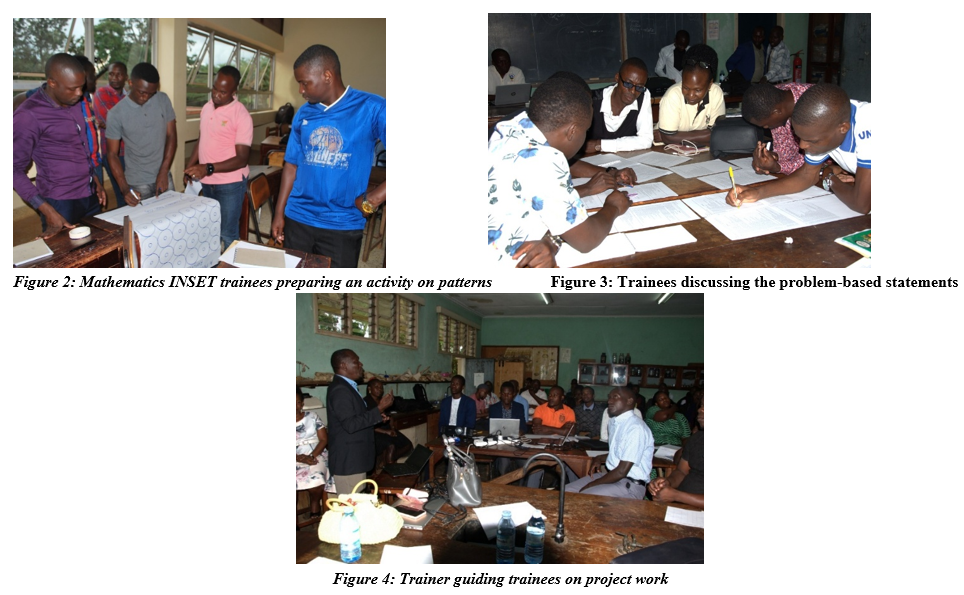
1.5 Challenges (2024–2025 INSETs)
- Continuity gaps: Late reporting, absenteeism, and missed prior CPDs made it difficult for some participants to link new content with earlier concepts such as content framework, test framework, and item specification.
- Time constraints: INSETs were conducted under tight schedules, leaving critical areas—especially project work—insufficiently addressed, despite requests for more time to cover all phases.
- Facilitation gaps: Inadequate support from some headteachers limited teacher participation and weakened the overall impact of the training.
1.6 Recommendations (2024–2025 INSETs)
- Teacher Commitment & Attendance:
Teachers should be encouraged to attend all INSETs, report on time, and maintain consistent participation to ensure continuity of learning.
- Headteacher Support & Facilitation:
The Regional Management Committee (RMC) should actively engage and remind headteachers of their responsibility to facilitate and support their science and mathematics teachers’ participation in INSETs.
- Time Allocation & Program Design:
Adequate time should be allocated for INSETs, with programs running for at least five days under the Ministry of Education and Sports through the SESEMAT National Office, to ensure thorough mastery of concepts.
- Content Depth & Focus:
More time should specifically be dedicated to project work so participants can experience all phases. Additional INSETs should be organized with a strong focus on assessment to strengthen teachers’ capacity in this critical area.
2.0 Executive Summary (Support Supervision 2024–2025)
Support supervision across Mukono, Kayunga, and Buvuma districts in 2024–2025 strengthened the implementation of the New Lower Secondary Curriculum (NLSC). It consolidated INSET gains by equipping teachers with skills in assessment, promoting learner-centered pedagogy, and encouraging schools to embrace competence-based approaches. Conducted in 88 schools, supervision revealed progress in teacher practice but also highlighted gaps in attendance, contextualization of learning, time allocation, and administrative support. Addressing these challenges through increased CPDs, targeted sensitization, and stronger institutional facilitation will be key to sustaining competence-based teaching and learning.
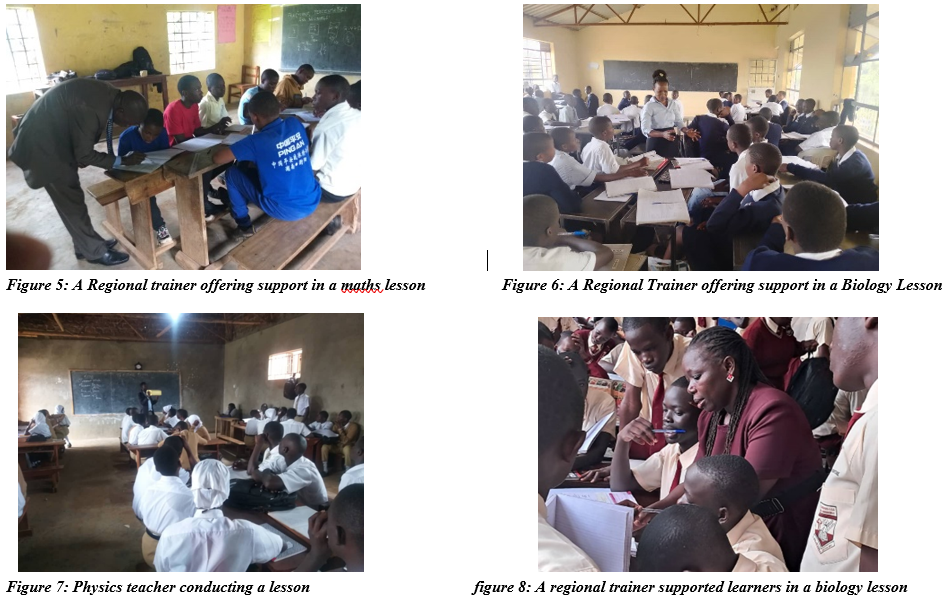
2.1 Objectives, Achievements, Challenges, and Recommendations
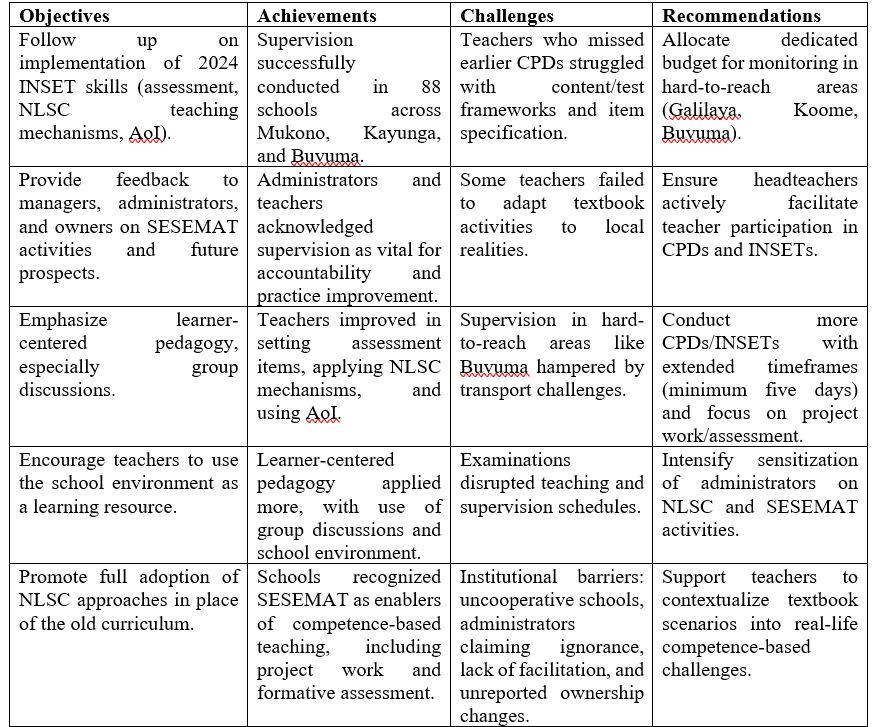
3.0 SESEMATACTIVITY – REGIONAL BASED (SARB) IN UGANDA’S COMPETENCY-BASED FRAMEWORK
SARB was introduced in Uganda as a transformative supplementary activity to strengthen teachers’ capacity within their own work context. Unlike traditional INSETs, which are limited to a few days in a year and often incur significant costs, SARB makes continuous professional development (CPD) regular, accessible, and sustainable at the school level.
In Mukono Region, SARB has become a cornerstone of teacher support, designed not only to complement INSETs but also to ensure that competence-based teaching is consistently applied throughout the year. The activity centers on rigorous end-of-year assessments, used to evaluate the quality of teaching and learning in the region. In 2025, this initiative was administered to Senior 3 learners, with assessments developed strictly in line with the specifications of the New Lower Secondary Curriculum (NLSC).
Through SARB, Mukono has demonstrated that effective teacher growth and quality assurance in learning are best achieved when professional development is continuous, context-driven, and directly linked to classroom practice
3.1 Specific Objectives (Thematic Summary)
- Assessment Design: Develop standard end-of-year assessment items for Senior 3 and produce clear scoring guides across the four subjects.
- Administration: Prepare test papers and ensure their timely distribution to all schools in the region.
- Coordination: Work with teachers to apply scoring guides consistently and fairly.
- Reporting: Analyze results and generate a comprehensive report to inform teaching and learning improvements.
3.2 Achievements
- The SARB activity was successfully conducted between 28th August and 17th November 2024.
- Standardized assessment papers across the four subjects (Physics, Chemistry, Biology and Mathematics) were developed, administered, and completed.
- Learner scores were systematically collected, analyzed, and compiled into a comprehensive report to guide teaching and learning improvements.
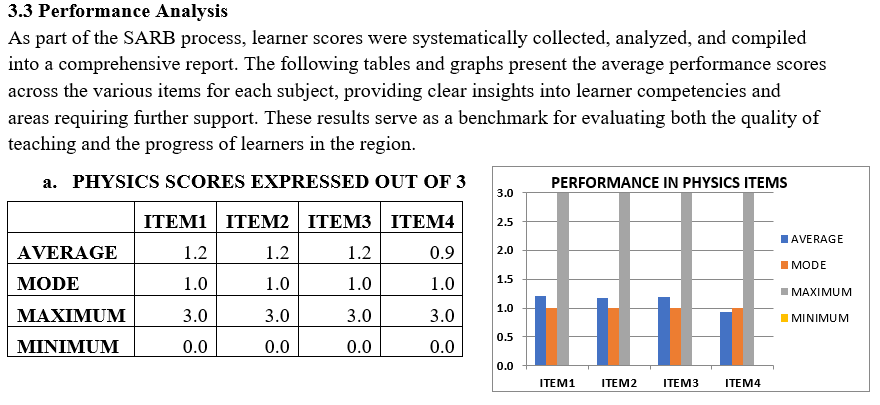
The Physics results showed that the average score across the four items was just above 1, with the most frequent score being 1 out of 3. This indicates that the majority of learners demonstrated only basic levels of competence, highlighting the need for stronger teaching and learning strategies in Physics. Evidence from support supervision suggests that this challenge stems from limited use of high-quality, scenario-based learning activities and assessments. In many cases, teachers relied heavily on activities from learners’ books, which were often not sufficiently contextualized or suited to the learners’ environment.
Nevertheless, the results also revealed important variation: while some learners achieved the maximum score, others scored zero. This points to disparities in learner engagement and mastery that need to be addressed through more targeted, context-driven instructional practices.

The mathematics results revealed that the average score across the four items was slightly below 1, with the most frequent score recorded as 0 out of 3 for items 2, 3, and 4. This shows that the majority of learners demonstrated only basic competencies, signaling that the teaching and learning of Mathematics requires significant improvement.
Findings from support supervision suggest that this weakness arises largely from the failure to link classroom activities to real-life contexts. Many teachers rely heavily on learner book exercises, which are often limited in quality and not sufficiently adapted to the learners’ environment. As a result, opportunities for problem-solving and scenario-based learning remain underutilized.

The Biology results showed a moderate average score in item 1, as reflected in both the average and mode bars. However, for items 2, 3, 4, 5, and 6, the most frequent score was zero, which significantly pulled down the overall average. This indicates that many learners struggled with these areas, pointing to gaps in teaching and coverage.
One likely explanation is that several schools had not yet taught some of these topics, even though they should have been covered by Senior 3 at the time of assessment. This gap underscores the need for Biology teachers to examine the unique challenges associated with these particular topics and ensure they are fully addressed in the curriculum sequence.
It is, however, encouraging to note that some learners were able to achieve the maximum score on certain items. This demonstrates that with consistent coverage and stronger teaching strategies, higher performance is possible across the board.

The Chemistry results showed that the average score across all six items was below 1 out of 3, with the most frequent score being zero in every item. Although the average remained above zero, overall performance was weighed down by the large number of learners who consistently scored 0, even when some achieved moderate scores. This pattern indicates that the majority of learners displayed only basic competencies, highlighting the urgent need to strengthen the teaching and learning of Chemistry.
Support supervision suggests that this challenge is largely due to the failure to connect Chemistry concepts to real-life contexts. Many teachers rely heavily on activities provided in learners’ books, which are often limited in quality and not sufficiently adapted to the learners’ environment. This has restricted opportunities for problem-solving and scenario-based learning.
Nevertheless, the results also revealed that a number of learners were able to achieve the maximum score in certain items, proving that with well-designed, contextualized learning experiences, stronger performance is possible.
3.4 Comparative Analysis Across Subjects
Across the four subjects, a common trend emerges: the majority of learners demonstrated only basic levels of competence, with average scores often below or just above 1 out of 3 and the most frequent score being 0 in many items. Physics and Mathematics reflected weaknesses in linking concepts to real-life problem-solving, while Biology revealed clear coverage gaps in key topics, and Chemistry highlighted the heavy reliance on textbook activities with little contextualization. Despite these challenges, every subject recorded instances where learners achieved the maximum score, underscoring the potential for higher performance when teaching is contextualized, scenario-based, and competency-driven. These results reaffirm the urgent need for innovative pedagogy, consistent curriculum coverage, and real-world application of STEM concepts to move learners beyond basic competence toward mastery.
3.5 Challenges
- Insufficient preparation time: Critical phases of SARB preparation were rushed due to limited time.
- Non-compliance with schedules: Some schools failed to follow the suggested timetable, disrupting consistency.
- Weak accountability: A number of teachers submitted results that were not properly authenticated.
3.6 Recommendations
- Extend preparation timelines: Increase the number of days allocated for setting and refining assessment items.
- Strengthen accountability: Involve school administrators directly in strict administration and authentication of results.
4.0. REGIONAL SCIENCE FAIR.
Mukono Region organizes annual science fairs as a dynamic platform to strengthen STEM competence among learners. These fairs follow a progressive model—beginning at school level, advancing through district competitions, and culminating at the regional level, where the best teams are selected to represent Mukono at the National Science Fair.
The 2024 Regional Science Fair, held on 27th July at Mukono High School, provided an exciting space for innovation, creativity, and collaboration.
4.1 Specific Objectives
- To showcase innovative STEM projects developed by learners across the region.
- To nurture learners’ generic skills such as problem-solving, creativity, collaboration, and communication.
- To identify outstanding projects to represent Mukono Region at the National Science Fair.
- To foster peer-to-peer learning, enabling learners to share experiences, inspire one another, and grow together.
